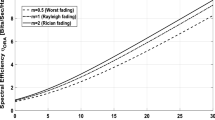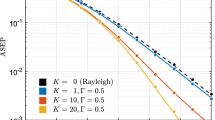Abstract
The paper deals with dual diversity reception of M-ary differential phase-shift keying modulated signals in the presence of additive white Gaussian noise and Nakagami-distributed slow and nonselective fading. The performance of a switched diversity system is analysed and compared to that of the predetection selection diversity combining scheme. The general case of correlated diversity branches is considered, without restrictions on the fading severity parameter. Average symbol error rate formulas are analytically derived in terms of integral expressions that can be easily computed via numerical integration routines. Moreover, the numerical evaluation of the optimum switching threshold is carried out and the influence of the fading severity parameter, the branch correlation, and the cardinality of the symbol alphabet is analysed. Finally, three fixed switching threshold strategies that allow to obtain a satisfactory diversity gain are considered.
Similar content being viewed by others
References
M. Nakagami, “The mdistribution — A general formula of intensity distribution of rapid fading”, in Statistical Methods in Radio Wave Propagation, W. G. Hoffman (ed.), Oxford, England, Pergamon Press, 1960.
U. Charash, “Reception through Nakagami fading multipath channels with random delay”, IEEE Trans. Commun., vol. COM-27, pp. 657–670, April 1979.
Y. Miyagaki, N. Morinaga, and T. Namekawa, “Error probability characteristics for CPSK signal through m-distributed fading channel”, IEEE Trans. Commun., vol. COM-26, pp. 88–100, January 1978.
T. Aulin, “Characteristics of a digital mobile radio channel”, IEEE Trans. Veh. Technol., vol. VT-30, pp. 45–53, February 1981.
H. Suzuki, “A statistical model for urban radio propagation”, IEEE Trans. Commun., vol. COM-25, pp. 673–680, July 1977.
G. L. Turin, W. S. Jewell, and T. L. Johnston, “Simulation of urban vehicle monitoring systems”, IEEE Trans. Veh. Technol., vol. VT-21, pp. 9–16, February 1972.
S. Okui, “Probability of cochannel interference for selection diversity reception in the Nakagami m-fading channel”, IEE Proc., Part I, vol. 139, pp. 91–94, February 1992.
H. Hashemi, “The indoor radio propagation channel”, Proc. IEEE, vol. 81, pp. 943–968, July 1993.
W. R. Braun and U. Dersch, “A physical mobile radio channel model”, IEEE Trans. Veh. Technol., vol. 40, pp. 472–482, May 1991.
M. Schwartz, W. R. Bennett and S. Stein, Communication Systems and Techniques. New York, McGrawHill, 1966.
M. A. Blanco and K. J. Zdunek, “Performance and Optimization of Switched Diversity Systems for the Detection of Signals with Rayleigh Fading”, IEEETrans. Commun., vol. COM-27, pp. 1887–1895, December 1979.
C. K. Pauw and D. L. Schilling, “Probability of error for M-ary PSK and DPSK on a Rayleigh fading channel”, IEEE Trans. Commun., vol. COM-36, pp. 755–756, June 1988.
F. Adachi and K. Ohno, “BER performance of QDPSK with postdetection diversity reception inmobile radio channels”, IEEE Trans. Veh. Technol., vol. 40, pp. 237–249, February 1991.
T. T. Tjhung, C. Loo and N. P. Secord, “BER performance of DQPSK in slow Rician fading”, Electron. Lett., vol. 28, pp. 1763–1765, August 1992.
E. K. Al-Hussaini and A. A. M. Al-Bassiouni, “Performance of MRC diversity systems for the detection of signals with Nakagami fading”, IEEE Trans. Commun., vol. COM-33, pp. 1315–1319, December 1985.
N. C. Beaulieu and A.A. AbuDayya, “Analysis of equal gain diversity on Nakagami fading channels”, IEEE Trans. Commun., vol. 39, pp. 225–234, February 1991.
M. A. Blanco, “Diversity receiver performance in Nakagami fading”, in Proc. IEEE Southeastern '83 Conf., Orlando, FL, pp. 529–532.
M. Tanda, “Bit error rate of DQPSK signals in slow Nakagami fading”, Electron. Lett., vol. 29, pp. 431–432, March 1993.
G. Fedele, “Error probability for detection of MDPSK signals in slow nonselective Nakagami fading”, Electron. Lett., vol. 30, pp. 620–622, April 1994.
G. Fedele, L. Izzo and M. Tanda, “Dual diversity reception of Mary DPSK signals over Nakagami fading channels”, Proc. IEEE Sixth International Symp. on Personal, Indoor and Mobile Radio Communication (PIMRC '95), Toronto, Canada, pp. 1195–1201.
A.A. Abu-Dayya and N. C. Beaulieu, “Analysis of switched diversity systems on generalized-fading channels”, IEEE Trans. Commun., vol. 42, pp. 2959–2966, November 1994.
A.A. Abu-Dayya, “Wireless Digital Communications on Fading Channels with Diversity and Interference”, Ph. D. Dissertation, Queen's University, Kingston, Ontario, Canada, August 1992
R. F. Pawula, S. O. Rice and J. H. Roberts, “Distribution of the phase angle between two vectors perturbed by Gaussian noise”, IEEE Trans. Commun., vol. COM-30, pp. 1828–1841, August 1982.
M. Abramowitz, I. Stegun, Handbook of Mathematical Functions. New York, Dover, 1970.
I. Gradshteyn, I. Ryzhik, Tables of Integrals, Series and Products. New York, Academic Press, 1980.
Author information
Authors and Affiliations
Rights and permissions
About this article
Cite this article
Fedele, G. Switched Dual Diversity Reception of M-ary DPSK Signals on Nakagami Fading Channels. Wireless Personal Communications 8, 53–72 (1998). https://doi.org/10.1023/A:1008870809361
Issue Date:
DOI: https://doi.org/10.1023/A:1008870809361




